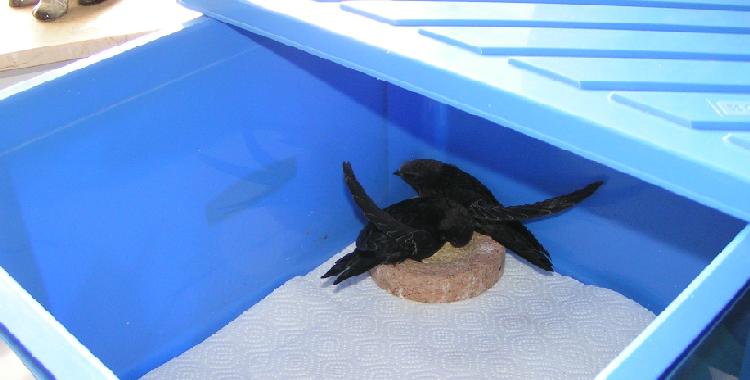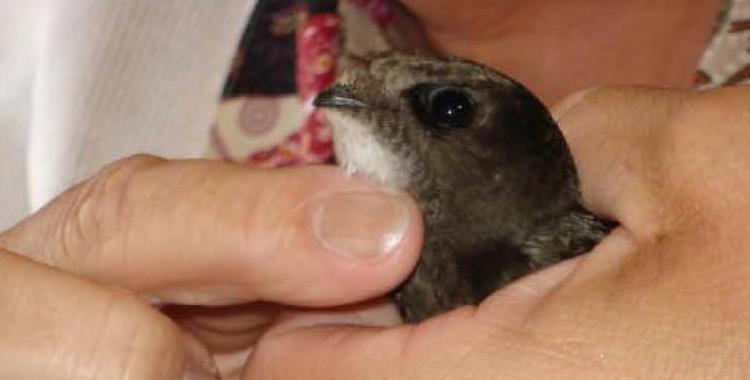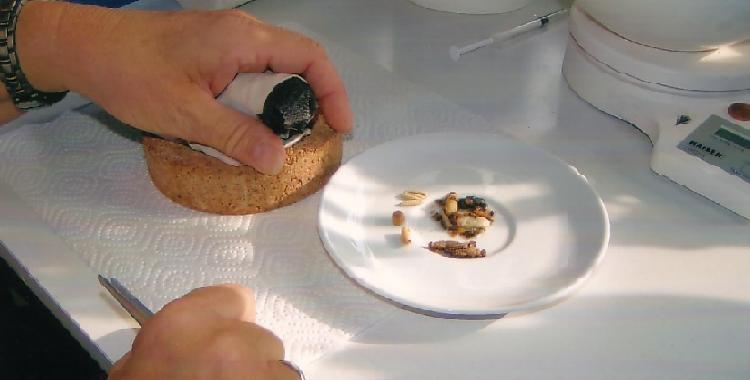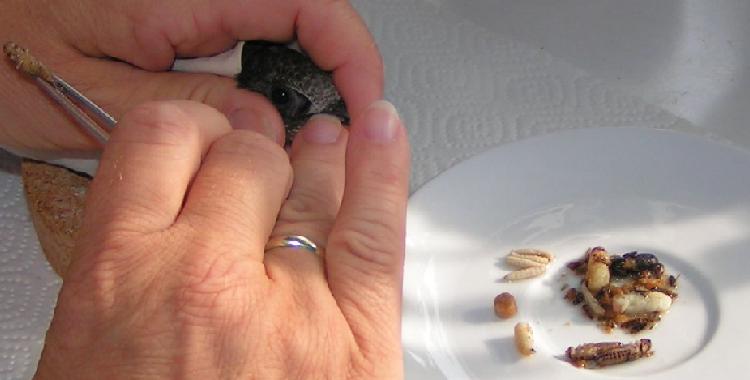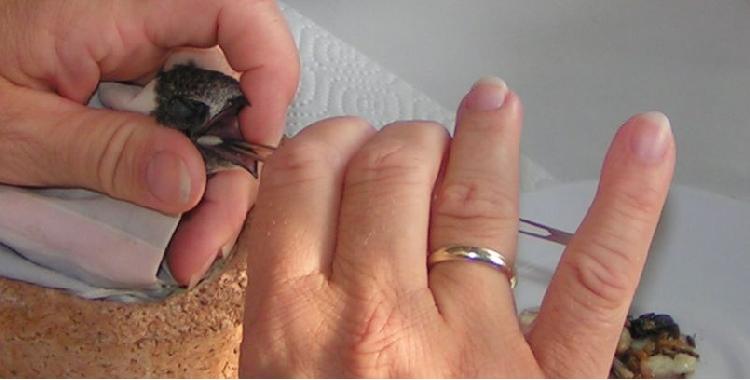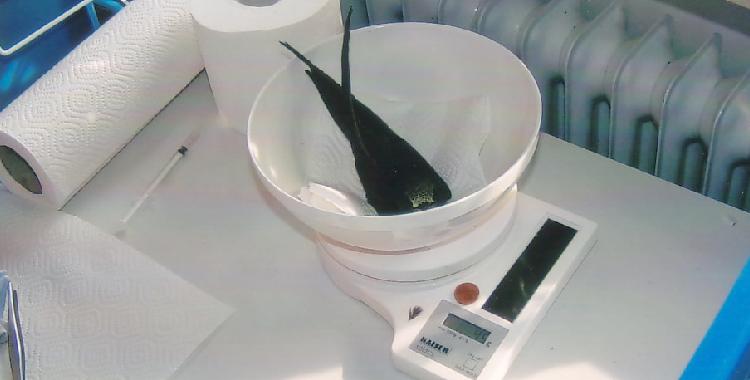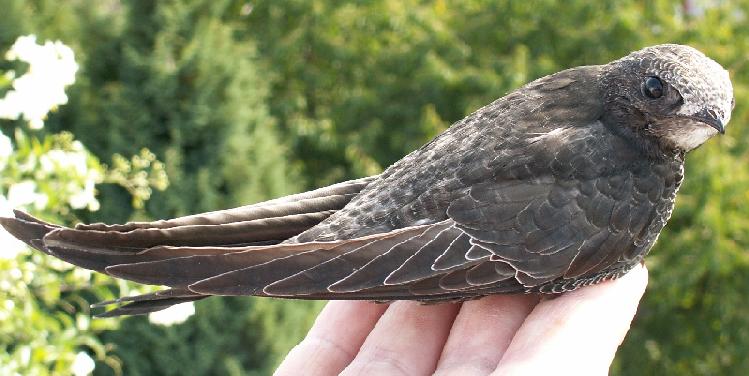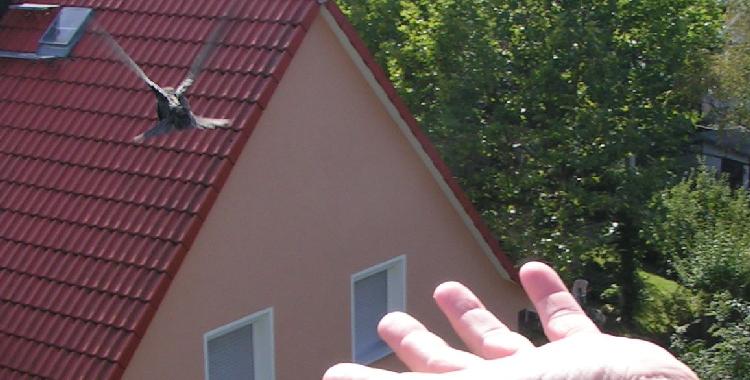
|
|
|
Hilde Matthes worked as a volunteer at the Common Swift Rescue Centre in Frankfurt am Main, which is supported by the German Society for the Common Swift, where over several years she reared hundreds of young Swifts. Today she works privately, and every July and August helps about 70 Swift chicks fly away as strong, healthy birds. |
|
|
Hand-rearing of Common Swifts (Apus apus)
The Common Swift is an especially difficult species to rear successfully. This is not something that amateurs can easily achieve, and it is best for the Swift if you can find an expert to take over the task. If this is not possible, the following is a guide to what needs to be done to raise the bird successfully.
Where to keep a Young Swift
One should never put Swifts in a birdcage, because they will panic, struggle and damage their feathers. If the long wing feathers are damaged, the Swift cannot fly. Swifts are best kept in a half-open plastic box, a minimum of 30 cm long, 20 cm broad and 15 cm high. It is vital that the birds have a clean environment to exercise their wings; feather soiling from faeces is to be avoided at all costs. So you must put some kitchen paper in the bottom. You can cover the faeces with a piece of toilet paper, but the box must be fully cleaned out every day. I put a nest made of either wood or cork in a dark corner of the box. If this is not possible, a glass bowl will do, but it must be wrapped in cloth, so that the chick does not lose body heat.
Keep the fosterlings in a half-open container of about 30 x 20 x 15 cm. Photo: Meierjürgen
A lone young Swift often just sits calmly on the nest. But if there are two or more chicks in the nest, they preen each other and one can hear them make soft purring contact calls. After feeding, this sound sometimes stops for a little while, but when they get hungry, it starts up again, first softly, then gaining strength. When the time comes for the chicks to fly, they stop making this typical nestling sound.
Common Swifts on the nest often preen each other, especially on the head and throat. This creates a relaxed mood. When hand rearing, I try to imitate this behaviour. Such soft preening can calm an exited Swift, and it establishes some confidence between the bird and the carer.
Soft preening of the throat calms the Swift down. Photo: G. Kaiser
The food
The Common Swift is a pure insectivore. The adults feed the chicks several times every day with compressed food balls made up of different kind of insects, all caught in flight. I try to keep as close as possible to this natural situation, by feeding the chicks seven times a day with a matching variety of insect ingredients. The quantity of food given to the chick depends upon its age and condition. A healthy Swift chick aged from 14 to 18 days upwards will need about 15 to 18 grams of food each day.
I make up the following mixture (these quantities are for a three to six week-old Swift): - 2 or 3 house crickets (1-2 cm long) - 3 or 4 bee drones - ½ a wax moth larva - some fly (fishing bait) maggots - flies - 1/8 tea-spoon dried insect food (not treated with vegetable oil) - 1 “Beo-pearl” vitamin capsule (Brand-name of the German company “Vitakraft”). This product is sold in the UK as "Beo Special". It can also be obtained in some other European countries. If it is not available, you should just omit it from the food mix.
Once a day: Vitamin and calcium supplements
You can buy crickets and wax moth larvae from specialist pet shops, or else by mail order from internet-based traders such as Livefoods Direct Co.Uk. Drone bees can be obtained from beekeepers (try your local bee keeping association). Fly maggots can be purchased from fishing tackle supply shops. They can be hatched out in any warm place, and if need be can then be frozen. Always keep adequate supplies in reserve.
Preparation of the meals
First - clean your hands thoroughly with a disinfectant hand wash.
Every meal must be freshly prepared. Each Beo-Pearl has to be soaked in water for 30-60 minutes.
The dried insect food has to be carefully cleaned : Pick out all harmful alien matter, like stone fragments or twigs, and discard them. Put the dried and cleaned insect food, together with the deep frozen items into warm water, and when the food has reached room temperature, put it in a sieve to drain. Then lay the food out on a plate. The food should smell good. If, for example, a cricket smells bad, it is rotten and must be discarded. Remove the bristly legs of the crickets before feeding. Mash up the maggots and use them as a binder for the dryer food items.
It does not matter if one or two ingredients are absent. Just crickets, flies and dried insect food, plus the supplements should assure success. You do not need to add water if the dried insect food has been properly soaked.
To feed the Swift, wrap a tissue carefully around the chick, so that the feathers cannot become soiled. Photo: Meierjürgen
Feeding technique
Before feeding I wrap a paper tissue loosely around the chick, and hold the bird gently in my left hand. One has to take great care to avoid any soiling of the feathers from spilled food. Then I open the bill, very carefully, with a fingernail of my right hand, and then smoothly insert my forefinger of the left hand into the side of the bill to keep it open. (See both photos below). This must be done really very gently indeed so that the fragile bill is not bent or broken. A Swift's bill is surprisingly delicate.
Open the soft bill carefully with a clean fingernail. Photo: Meierjürgen
Then I put the pieces of food very carefully deep into the gorge with blunt, round-ended tweezers (obtainable at pharmacies, or else ask your vet). If you do not put the food in deep enough, the chick may vomit it out, or eject it by shaking its head.
Keep the bill carefully open with the finger. Then, using the blunt tweezers and taking great care, put the food items deep into the gorge. Photo: Meierjürgen
When a chick is really hungry , I give it some additional food.
When the chick is helpless and has no strength, you need to start feeding very slowly. You start with one or two single food items (e.g. flies or drones) and after an hour or so, you repeat the process. If need be, you do this right through the night.
You then very slowly increase the Swift's rations until it is eating the normal diet, described earlier. In such difficult cases, I add at every meal a drop of liquid (1/2 Amynin + 1/2 water) using a medical syringe (without the needle).
If the chick sucks your finger do not discourage it, as this actually helps the feeding process. It makes it easier to insert the food, which is then readily swallowed.
Unless it is absolutely essential, I do not de-worm the chicks, but try and keep them as naturally as possible.
Monitoring the Chick's Weight
I record each chick's weight daily. This record gives me the data needed to measure the progress towards flight, as well as the general health of the bird.
The chick is developing well and almost ready to fly when it weighs 50 grams or even more over a few days. In the few days left before it flies, it will refuse food and lose weight, until it goes down to 40-45 grams, when it will be ready to go.
Daily weighing is essential to record the chick's growth. Photo: Meierjürgen
The release
The birds are ready to go when the long wing feathers have lost all their whitish protective coverings. The flight feathers should be about 16 cm long, and extend at least 3,5cm beyond the tail feathers. Swifts do not practice flying at all. Once they are launched, they fly, and then stay aloft for two years before they land to breed. The chicks do however strengthen their flight muscles by performing "press ups", pressing their wings to the floor and lifting their bodies high off the ground.
I choose a good-sized lawn, or a just-cut meadow to release my Swifts on. Then, if something goes wrong, the chick has a soft landing, and can easily be seen and recovered. For the "launch" the Swifts need ample airspace and some height up off the ground. Standing on a small step-ladder gives sufficient height. I never forget to check for Falcons. If they are around I wait until they have left the area before making the "launch".
I stand on the ladder, with the young Swift sitting in my open hand. It will take some time to orient itself. In most cases it will defecate, and then after a couple of minutes it will fly away safely and strongly. It is very satisfying to see it flying high into the sky with one own eyes, or with binoculars! But if it clings to your hand or crawls backwards, it is too early to let it go. You should take it back home and look after it for a few more days. Never throw it into the air!
This young Swift is ready to fly. The feathers are fully grown, and have no traces left of the infant down. Photo: Meierjürgen
Weather conditions on the day of release should be dry, and if possible, (check the satellite images on the TV) dry as far as the middle of France or even the Pyrenees, because the birds will mostly head straight for Africa.
Common Swifts receive no help from their parents. Right from the start they fly perfectly, and achieve everything by themselves, alone.
A successful recovery
Nestling Swifts fly off, usually never to be heard of again, so low is the rate of recovery by bird ringers. So I was very pleased when one of "my“ Swifts, reared in 2004, was recorded in 2005 at Kronberg in the Taunus hills. All of the hand-raised Swifts are ringed with a number, and this bird was noted by ornithologists when it was searching for a nesting place. The ring number confirmed that it was one of "my" fledgelings. For more information click here
The fledgling looked around, oriented itself, then spread its wings and flew away. Photo: G. Kaiser
This recovery shows that both the hand rearing techniques, and the diet, were fully successful. This is important, because, as mentioned above, Common Swifts are very difficult to foster. Their feathers are easily malformed, or even lost, if anything in their diet is in any way inadequate. This recovery is confirmation that the recommended food mixture is sound, and can be applied with confidence.
© APUSlife No. 3124 ISSN 1438-2261
Versions in other languages are available: Russian http://www.commonswift.org/Hand_rearing_russian.html Italian http://www.commonswift.org/Allevamento German http://www.commonswift.org/Handaufzucht.html
Further information:
Hints for veterinarians http://www.commonswift.org/Veterinary-Help-for-Common-Swifts.htm
Photos of young Swifts useful for assessing their age http://www.commonswift.org/nestlings_english.html
The following two video clips show the feeding process conducted by a very experienced feeder. http://de.youtube.com/watch?v=02js4857WH8 This one shows how an adult Common Swift is fed; one can see that the bird tries to withdraw its head.
http://de.youtube.com/watch?v=e2Y5BR-b_uw This one shows an "easy" chick. But many chicks behave like adults, i.e. they are unwilling to eat, and so must be fed with a gentle assisted feeding technique.
Should you try to feed a Common Swift yourself, you may find it to be much more difficult than the videos show! Be patient, calm and always extremely gentle. Treating the bird forcibly will not make it co-operate any better and will probably severely injure it. In such cases it is best for you and the bird to give up and take it to an experienced handler before causing any more suffering from insufficient food, a broken bill or ruined plumage.
GILLIAN WESTRAY:
A case study to complement Hilde Matthes's instructions: The Hand-rearing of Common Swifts (Apus apus)
This nestling was admitted on 24-06-2008; a typical case of dehydration and starvation.
Estimated 15-16 days old. Weight 22 grams. Normal weight should have been 35-38 grams. Bird was very thin & cold, eyes sunken, mouth greyish white. Placed into an insulated container, and warmed very gently from below. For the first 4 hours given oral infusions of re-hydration fluid every 30 minutes, followed by diluted liquid feed for 12 hours. (Every 2 hours overnight).
25-06-08 - 24 hours later 24g & hungry.
This patient apart from acute starvation, most likely due to the weather, had no obvious injuries or disorders.
Each bird is different and needs to be treated accordingly. Beneath each photo I indicate the food intake needed to attain the ideal growth pattern and weights for this particular Swift. The appetites and size of individual birds vary, therefore it may be necessary to adjust the food quantity (up or down) a little to achieve these weights.
Oral infusions should not be undertaken by the inexperienced. Please refer to: "Veterinary Help for Common Swifts by Christiane Haupt", the section on Dehydration & Malnutrition. http://www.commonswift.org/Veterinary-Help-for-Common-Swifts.html
The Diet
Specialists consider this to be the most suitable substitute diet for Swifts, Swallows and House Martins.
The soft bodies of large silent crickets (Gryllus assimilis), wax moth larvae (Galleria mellonella) with pierced skins to aid digestion, dusted with Vitamin & calcium supplement (insect essentials e.g. from The Birdcare Co.), home bred flies. Add flies to soak up the juices. (Keep plenty of frozen flies and crickets in reserve, wax moth larvae have a good shelf life.)
Feeding times: 6am - 9pm at regular intervals, number and size of meals per day as indicated.
Small meal: 2-3 medium crickets 1-2 wax worms 3-4 flies Medium meal: 5-7 medium/large crickets 2-3 wax worms 4-5 flies Normal meal: 8-10 medium/large crickets 3-4 wax worms 5-6 flies
Small quantities of finely chopped insects were then introduced as detailed in Hilde Matthes's instructions for "Helpless Chicks" in the section on "Feeding Techniques". The older the chick, the more difficult. The company of other Swifts is a very important aid. The care of any Swift is an enormous commitment and should not be undertaken lightly.
The following series of photographs illustrate the progress of a captive reared Common Swift nestling. Feather development and weight compare favourably at every stage to a naturally reared bird. The number of meals refers to the daily intake.
25-06-08 Weight 28g. 14 small meals chopped up
26-06-08 Weight 31g. 12 normal meals. A more natural environment with 2 smaller orphans
29-06-08 Weight 41g. Now an adequate weight
29-06-08 Weight 41g. 10 normal meals
30-06-08 Weight 43g. 10 normal meals
01-07-08 Weight 46g. 9 normal meals
03-07-08 Weight 50g. 9 normal meals
04-07-08 Weight 52g. 9 normal meals
05-07-08 Weight 53g. 8 normal meals
06-07-08 Weight 52g. 8 normal meals
07-07-08 Weight 50g. 7 normal meals. Press-ups and wing beating start
09-07-08 Weight 50g. 6 normal meals. Appetite reducing
11-07-08 Weight 49g. 6 normal meals
13-07-08 Weight 48g. 6 normal meals
15-07-08 Weight 46g. 6 medium meals
15-07-08 Increased exercising & starting to resist some meals
17-07-08 Weight 45g. 5 medium meals
19-07-08 Weight 44g. 5 small meals
20-07-08 Taking an interest in the outside world
20-07-08 The two companions fledged 24th & 25th July 2008
21-07-08 Weight 43g. Fledged well, joining other swifts high in the sky
This beautiful Common Swift was the first orphan of 2008, and being quite young at admission made hand rearing easier.
© APUSlife No. 3972 ISSN 1438-2261
Print version Matthes Westray Hand rearing Commonswifts |
Commonswift Worldwide © Ulrich Tigges
Apus apus, Swifts, Commonswift, gierzwaluw, vencejo comun, sis hachomot, סיס החומות, Црна чиопа, Kara Sağan, Čiopa, ciopa, chyorny strizh, Gierzwaluw (Apus apus), Vencejo común, Черный Стриж, Martinet noir, Rondone comune, rondoni, åtactara, السمامة, Mauersegler, Apuslife
Commonswift's topography, togography of the Commonswift, feathers, crown, eye line, eye patch, forecrown, lore, chin, throat, ear coverts, hindneck, mantle, scapulars, rump, uppertail coverts, tail, tertials, greater coverts, secondaries, median coverts, leading edge coverts, lesser coverts, lesser primary coverts, alula, median primary coverts, leading edge coverts, greater primary coverts, primaries, median coverts, greater coverts, secondaries, axillaries, undertail, undertail coverts, rear flank, vent, flank, belly, brest, apodidae, apodiformes, size, color, colour, weight, sex, flight acquaintance, flight speed, age, food, enemies, pair bonding, nest, eggs, egg, young, bad weather, voice, download wave file, survive, survival, colony, flying insects, baby bird, hand rear a baby swallow, baby swallow
